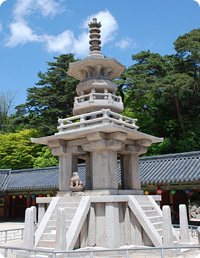+WINTER OLYMPICS
Post-Olympics 7 days
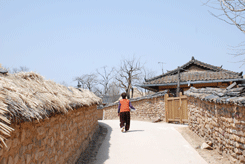
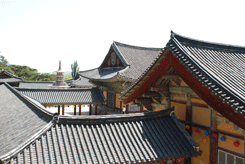
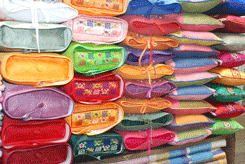
Click on the days to access the programs quick
| Days | Visits and Activities | Distance |
| Day 1 | Pyeongchang - Punggi - Andong | 240km |
| Day 2 | Andong - Yeongdeok - Gyeongju | 170km |
| Day 3 | Gyeongju | |
| Day 4 | Gyeongju - Goryeong - Gayasan - Songnisan | 290km |
| Day 5 | Songnisan - Suwon - Seoul | 210km |
| Day 6 | Seoul | |
| Day 7 | Departure | 60km |
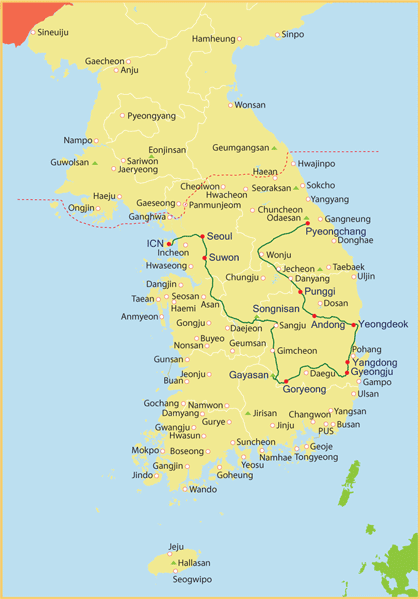 Day 1 Pyeongchang - Punggi - Andong (- - -) 240km
Day 1 Pyeongchang - Punggi - Andong (- - -) 240km
With leisurely time to pack, travel to Andong, a stronghold of Confucianism that has deeply influenced the lives of Koreans in all aspects. En route, you will visit Korea's first private school, Sosuseowon. It was a birthplace of Confucian education and a cradle of prominent scholars. It was established by Ju Se-bung in 1543 and named Baekundong Seowon. The compound itself is composed of two sections; academic studies and research, and memorial service. There are several old buildings where scholars learned and studied loyalty, filial piety, manners and knowledge. The institute has a Shrine, which was built to enshrine An Hyang, An Bo, An Chuk and Je Se-bung, where a memorial service takes place twice a year on the first day of the third and ninth months by the lunar calendar.
While in Punggi, experience ginseng market. There are small stalls in the building type market, all of which has piles of fresh ginseng roots, ginseng preserved in wine in fancy bottles, dried ginseng, tea, extract, candy, and honey ginseng slices. This mysterious root, which has a good smell better than it tastes, has historically been considered an empowering medicine and a cure-all; effective in recovering the liver's functions, improving anticancer and immunity functions, and treating diabetes, hypertension, low blood pressure and stress. Ginseng also facilitates recovery from fatigue and the activation of nervous cells. There are also many shops along the street leading out from the painfully quiet train station. Street vendors sell flowers, fruits, food stuff and home grown grains and vegetables. All these features mixed offer a rural ambience of Korea's remote town.
You will explore UNESCO World Heritage Site, Hahoemaeul from the 15th century. It is the best preserved traditional village portraying and spanning the life of the Joseon Dynasty (1392-1910) and some 480 Korean traditional houses, both large and small, are still fully functioning.
As you take a walk in the narrow alleys, enjoy the rustic and old charm of this unique village. You cannot possibly miss a 600-years old zelkova tree, the home to the village spirit. At the tree's base is where residents still make their wishes. The village is also known for traditional festival, Hahoe Mask Dance which gave common people the opportunity to mock those in authority, and in particular the Byeolsingut, a shaman ritual exorcising evil spirits, dating back to the Goryeo dynasty (918-1392).
Day 2 Andong - Yeongdeok - Gyeongju (B) 170km
Yeongdeok is a place of fishing villages, beaches, mountains, and snow crabs. The crabs are sold throughout Korea, but the ones in Yeongdeok are both the freshest and the best. As you stroll down the streets brimming with numerous snow crab restaurants, enjoy a rural ambience of the fishing port.
Explore UNESCO World Heritage site of Yangdongmaeul, a traditional clan village which embraces simple, unadorned natural beauty. Sheltered by forested mountains and facing calm rivers and open fields, the rustic tile and thatch-roofed homes of this village are in perfect harmony with the natural topography. During the Joseon dynasty (1392-1910), this village housed mostly middle upper-class families and contained over 150 homes as well as two shrines. These homes and shrines were built according to the harmonious theory of Yin and Yang and have been handed down from generation to generation in their original elegant forms.
Gyeongju is an ancient capital of the Silla dynasty (BC57-AD935), often dubbed as Museum without Walls. Today, you are treated to one of the ten most historically significant sites in the world with ancient temples, weathered stone pagodas, royal tombs, Buddhist bas-reliefs, and fortress ruins.
Day 3 Gyeongju (B)
With a full day to explore the delights of UNESCO World Heritage Site, Seokguram grotto. It is the home of the serene stone Buddha of the eighth century. Inside, a white statue of a seated Buddha in a sublime state of enlightenment, is surrounded by 37 relief figures of Bodhisattvas, disciples, devas, and guardian kings. The grotto represents the magnificent harmony of religion, science and the arts of Buddhism, symbolizing the pure land in which Buddha resides.
A short ride leads you to another UNESCO World Heritage Site, Bulguksa temple, where you will witness the impressive gates, symbolic bridges leading up to the world of Buddha, graceful architectures, Three-storied Seokgatap and highly ornate Dabotap blending well into the architectural harmony.
At Gwaneumjeon hall, check out the image of the Avalokitesvara who is referred to as the Bodhisattva of Compassion and has a thousand hands, and eyes in each so as to reach out to those in need of help. You will see a gilded statue of Vairocana with the gesture of the first wisdom, Sakyamuni Buddha along with sixteen figures of Buddha's disciples sitting in deep meditation, and a gilt-bronze Amitabha Buddha who is the ruler of the Western Paradise Sukhavati. The architectural design of Bulguksa is one of constrained dignity, peace, and harmony and the temple still remains one of the most remarkable achievements of the ancient Far East.
Visit Gyeongju National Museum for a great insight into Silla culture and history. The first thing that you will notice is The Bell of King Seongdeok, the largest extant bell in Korea. You must certainly stand in awe before the bell from the 8th century with such artistic beauty of design. The bell is distinguished not only for its outstanding beauty but also for its long reverberating sound, the incredibly precise casting technique, in addition to the sad legend surrounding it. On entering the museum, you will marvel at the priceless archaeological and historical artifacts including splendid gold crowns, earrings, belts, ornaments, glassware, potteries, and clay figures as well as a royal barge.
Continue your historic discovery by exploring Donggung palace and Wolji pond, a pleasure garden built to commemorate the victory of Silla. A short walking tour leads you to the ruins of Banwolseong fortress, the world's oldest existing astronomical observatory, Cheomseongdae and finally Tumuli Park that encompasses 23 huge burial mounds. You can go inside Cheonmachong and see how the tombs were made and replicas of the treasures excavated in 1973.
You will explore UNESCO World Heritage Site, Yangdongmaeul, a delightful journey to the traditional clan village which embraces simple, unadorned natural beauty. There are some steep hills to climb but also easier streets. Over 150 homes as well as two shrines are in perfect harmony with the natural topography, presenting different angles where walls ascend a hill interspersed with tiled roof houses or thatched roof buildings.
Day 4 Gyeongju - Goryeong - Gayasan - Songnisan (B) 290km
En route stop at Goryeong Tumuli Museum located below the group of ancient tombs, featuring a perfect replica of the Jisan-dong Tomb No. 44 itself, a large-scale living burial to be first discovered in Korea. Learn about the ancient sacrificial burial custom a funerary practice, burying humans or animals to accompany a deceased noble person. The practice was widely performed in ancient society and was, in part, practiced by the belief that even in the afterlife, attendants were required for the dead to continue to enjoy a certain lifestyle. You will see the main stone chamber that belongs to the master of the tomb. The king and two sacrificed bodies were laid to rest, and one sacrificed human body in each of three annexed chambers. Human bones of about 24 persons were confirmed in 32 additional stone coffins in the vicinity of the stone chambers. So, taking some completely decomposed bones into the count, about 40 persons were presumably entombed together. Such examples of massive human sacrifice have not been found in other ancient tombs of the era of the Three Kingdoms.
Neighboring Daegaya Museum exhibits a huge collection of artifacts excavated in Goryeong and you will also see them.
Your journey continues to Gayasan national park to see a magnificent Haeinsa temple from the 9th century, housing world's oldest and a complete collection of the Buddhist sutras. Haeinsa is one of the most important temples in Korea. They are Tongdosa, Heinsa, and Songgwansa, each of which represents Buddha, Dharma, and the community of followers or "sangha". The first gate to the temple is Iljumun which means "single pillar gate" and symbolizes a true path of enlightenment which leads to the world of Buddha. One has to climb 108 stairs to the last building in the compound from this gate. On each step one can renounce each of 108 worldly desires of the mind.
Following the stairs up, you will reach the main hall courtyard in the middle of which stands stone carved lantern and weathered stone pagoda. Within the main worship hall (Hall of Great Peace and Light), you will see Vairocana Buddha who is flanked on the left by Manjusri, the Bodhisattva of Perfect Wisdom, and on the right by Samantabhadra, the Bodhisattva of Perfect Compassionate Action, along with other Bodhisattvas including Avalokitesvara, vairocana, Ksitigarbha and Dharmogata. Behind the statues are highly detailed and rather unusual wall paintings of the Buddha's life. And on the outside walls are a fair number of paintings portraying Buddhist stories.
At the back of this hall is a group of four depositories or Janggyeong Panjeon from the 15th century. The depositories house 81,258 wood-blocks of Tripitaka Koreana, an offering to the Buddha for national protection from the looming Mongol forces. The printing blocks are some 70cm wide, 24cm long and 2.8cm thick on the average. Each block has 23 lines of text, each with 14 characters, on each side. Each block thus has a total of 644 characters on both sides. Some 30 men carved the total of 52,382,960 characters in the clean and simple style. The characters are perfectly carved as if from the same hand. They were completed in 1251 after 16 years of work in Jeondeungsa temple on Ganghwado and were transported here for safekeeping. Two long depositories are designed to have natural ventilation by facing different size windows in the front and rear of the building.
The Mongol forces eventually took over the Goryeo Dynasty but the wooden blocks remain preserved today having survived other invasions, wars and fire. Even more amazing aspect is that neither birds built nests nor spiders make webs on these buildings. Tripitaka Koreana and Janggyeong Panjeon have been designated by UNESCO as a World Heritage for their artistic as well as religious value. In order to control the temperature and humidity within the depositories and protect the Janggyeon Panjeon and woodblocks from fire, full-time security guards and a 24-hour surveillance system are in place.
Then journey onwards to the Songnisan national park, weaving through the countryside with its rural vistas. The Songni literally means an "escape from vulgar". The tour passes through Maltijae, a 12 hairpin turn, and shortly thereafter stands a 600-year-old pine tree. Shaped like an open umbrella, it is 15 meters high with a girth of 4.5 meters. This tree was granted a ministerial title when it reportedly lifted its branches in order to let king's palanquin pass in the mid 15th century. In recent years several branches were damaged by wind and snow, though what remains is still beautiful.
Explore Beopjusa temple. Founded in AD 553, the temple boasts of three national treasures and numerous cultural assets. Palsangjeon that houses eight paintings of different stages of the Buddha's life is the five story wooden pagoda constructed in early 17th century, and is a very rare and unique Buddhist architectural structure. Gazing down at the Palsangjeon is a 33 meter high and 160 ton Maitreya Buddha, the Buddha of the Future. The giant iron pot whose diameter is 2.7 meters that may well had been used to feed 3,000 priests in the early 12th century is on display in the temple courtyard. A stone carved lantern supported by twin lions standing face to face is a rare example of the magnificent Silla sculptures. A stone water cistern shaped like an open lotus flower is considered unique for beauty and design. This stone lotus blossom from the 8th century is supported by a round short stone carved like a mushroom. Nearby are two stone pillars which once held the temple banner pole. An excellent carved relief called Maaebul also can be seen.
The temple holds Four Buddhist Instrument
Ceremony at sunset. The bell, which almost all Korean temples are equipped with, is one of the four Dharma instruments together with Dharma drum, wooden fish, and cloud-shaped gong. Hearing it reverberating through the universe, you will reflect upon the profound symbolism of the instruments. It is a great vow to save, or enlighten, the creatures in the universe including those on land, in the sea, in the air and in hell. You cannot miss this amazing ceremony.
Day 5 Songnisan - Suwon - Seoul (B) 210km
While in Suwon, explore UNESCO World Heritage site of Hwaseong Fortress from the 18th century, and learn some of Korea's long history, see beautiful natural surroundings, and get a lot of exercise all at the same time. A 5.74km-long fortress enclosing both flatland and hilly terrain is parapeted with crenels and merlons and highlighted by four main gates and well over 50 structures including temporary palace where the king sought refuge during war and found rest during times of peace.
A walk through the whole fortress could take several hours but it is well worth making a short walking tour to enjoy the splendor of the fortress. Start the tour with a visit to Paldalmun gate, an imposing two-storey wooden pavilion standing on top of a stone structure with an arched entrance, which is shielded by a semicircular chemise built of brick and flanked by gate guard platforms on either side.
As you make your way to the fortress, you will see Suwon’s main commercial district with its conventional market retail outlets where the hustle and bustle of people shopping for food, vegetables, fish, meat, household items, clothing and tools. Then, explore sentry post perched on the edge of the turret, beacon tower which possesses five chimneys to create different smoke signals, and Changryongmun gate where builders names carved into the walls are evident. Beside the gate stands 6.8m tall watch tower in oval shape, having an internal spiral staircase leading up to the top. On the archery field, visitors hone their skills with a bow and arrow. A basic lesson is given in Korean archery or Gukgung before they try shooting on their own.
Check out the command post and secret gate leading down to the dark labyrinth. Inconspicuous and hidden out of sight, it was used by people and animals and to bring war munitions into the fortress. An exquisite pavilion called chasing after flowers and floating along with willow branches is located on a hill that overlooks a lotus pond surrounded by beautiful willow trees. Below the pavilion sits northern floodgate, a stone bridge with seven arched sluices topped by an elegant open pavilion and brick-built parapet, and a little further on is the Korea's largest Janganmun Gate.
Day 6 Seoul (B)
Your exploration this morning begins with a driving tour of Seoul, featuring sites such as Seoul Plaza, City Hall, Cheonggye Square and pedestrian-friendly Gwanghwamun Plaza that is hemmed in on both sides by rushing traffic and office buildings. The plaza is lined on each side with 365m long streamlets, two centimeters deep and one meter across, the stone bed of the plaza's east side waterway engraved with important events in chronological order from 1392 to 2008.
Standing high on a stone pillar is a statue of Yi Sunsin who had engaged in twenty-three naval battles and emerged victorious in all of them during the Hideyoshi invasion (1592-1598). King Sejong who propagated the Korean alphabet in the 15th century is also honored with prominent statue. On August 16, 2014, Pope Francis celebrated Mass in this plaza to beatify 124 Korean martyrs. Near the southwest corner of the plaza is Korea's Kilometer Zero, marking the distances to 64 cities around the world, including Seoul's antipode, Montevideo, Uruguay, 19,606km.
Step back in time to when life was gracefully slow and discover Gyeongbokgung palace, a particularly charming spot that represents a colorful and turbulent side of the capital's 500-year history. On entering the gate, you will step back in time to Joseon Dynasty (1392-1910). Depending on timing, you may witness the Royal Guard Changing Ceremony featuring parade, password verification, duty shift and patrolling the gate. Accompanied by a court band with its colorful costumes and royal flags, the ceremony is performed daily basis at 10:00 and 14:00 except Tuesdays, although it is cancelled in case of rain or extremely hot or cold weather.
The throne hall stands majestically on top of a two-tiered stone platform. At the back of this hall is a group of offices. Displayed in front of the King's official quarters is Angbuilgu. Check out this interesting sundial and learn how to tell time and 24 periods of seasonal change from the winter solstice to the summer solstice.
Sitting on the island in the rectangular lake is Gyeonghoeru. Supported by 24 each square and cylindrical massive stone pillars representing the idea of Yin and Yang, this magnificent pavilion was used for many purposes ranging from receptions to national examinations. Gangnyeongjeon is the king’s sleeping and living quarters while Gyotaejeon is the queen's domain containing a number of halls. The noted feature of these main buildings is an absence of a top roof ridge. You cannot miss Amisan Garden landscaped with four hexagonal chimneys in orange bricks which are seldom noticed by the hurried visitors. Jagyeongjeon is the queen dowager's residence. Although less colorful, it is worth noting the wall of Jagyeongjeon, adorned with floral designs and the chimneys with ten longevity symbols.
Hyangwonjeong features a small pond with a manmade islet that supports a beautiful two-story pavilion. Behind this serene garden is Geoncheonggung, where the king and queen could relax in peace and quiet. It was here that the first electric lights in the country were installed in 1887 after 8 years of Thomas Edison's invention and a tragic chapter in Korea's history was recorded when empress Myeongseong was assassinated by the sword-bearing Japanese assassins in the early morning of 8 October 1895, allegedly under orders from Miura Goro.
Your visit to the National Folk Museum of Korea will familiarize you with wealthy culture of this friendly and picturesque nation. It is an excellent facility to illustrate the history of traditional life of the Korean people from the prehistoric age to the Joseon dynasty. The permanent exhibition features life and work, costumes and ornaments, handicrafts and technology, educations, living quarters, dietary life, oriental medicine, performing arts and games, beliefs and rituals, and socio cultural life.
Jogyesa is the head temple of Jogyejong the principal sect of Korean Buddhism, emphasizing the Zen orthodox, meditation tradition and the purity of monastic celibacy. The Main Worship Hall holds triad Buddhas, Sakyamuni, Amitabha and Bhaisajyaraja. The figure in the center is Sakyamuni Buddha who has overcome greed, hatred and delusion. While here it is worth noting the 500 year old lacebark pine and 400 year old locust tree that still grace the property.
You will tour the centuries-old Namdaemun Market brimming with well over 11,000 shops selling anything you can imagine. One of the most colorful aspects of the market is an endless sprawl of street-vendor stalls that setup in the alleys and walkways between the buildings. The market is seriously crowded, so be prepared to get bumped around. A fantastic place to haggle over the price to get the best deal on something you want or simply admire the vibrancy of this massive market.
Enjoy a brief visit to Gwangjang market. It is one of few markets retaining traditional Korean atmosphere. Established in 1905, the market today has 5,000 independent shops. On the market's ground level, the floor space is dominated by scores of small snack stalls selling rustic delicacies and cheap treats. Clouds of smoke billow out from the boiling pans, diverse types of pancakes sizzle on hot iron grills and the smell from the eateries filling the air. The roadside vendors hawking everything from food, fruits, vegetables to seafood and an entire upper level dedicated to high quality silk, satin, and linen. Try out some sorts of Korean snacks and see a side of regular Seoul life.
Drive past Cheonggyecheon Stream. After the Korean War (1950-1953), more people migrated into Seoul to make their living and settled down along the stream in shabby makeshift houses. The accompanying trash and waste, and deteriorating conditions resulted in an eyesore for the city. The stream was covered with layers of concrete in the mid 1950s and roadway until the massive urban renewal project freed it in 2005. Today, a 5.8km creek tumbles gently through downtown Seoul, providing a much needed source of peace and relaxation for the citizens of this fast-paced city.
Day 7 Departure (B) 60km
After this wonderful visit to Korea, you will return to the airport in time for your flight. By boarding, you are already high above Incheon heading for home.





